 Last additions - Odani Castle 小谷城 Last additions - Odani Castle 小谷城 |
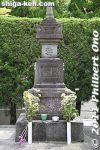
Grave of Azai Hisamasa (1526-1573) at Tokushoji temple in Nagahama, Shiga. He was the second lord of Odani Castle and father of Nagamasa. 浅井久政の墓 長浜市徳勝寺Jun 30, 2011
|
|
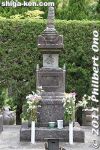
Grave of Azai Sukemasa (1491-1542) at Tokushoji temple in Nagahama, Shiga. He was the first lord of Odani Castle. 浅井亮政の墓 長浜市徳勝寺Jun 30, 2011
|
|
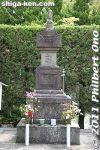
Grave of Azai Nagamasa (1545-1573) at Tokushoji temple in Nagahama, Shiga. He was the third lord of Odani Castle. 浅井長政の墓 長浜市徳勝寺Jun 30, 2011
|
|
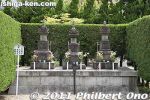
From left to right, the graves of Azai Nagamasa, Sukemasa, and Hisamasa at Tokushoji temple in Nagahama, Shiga. 長浜市徳勝寺Jun 30, 2011
|
|
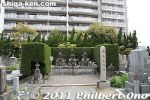
Graves of the Azai clan at Tokushoji temple.Jun 30, 2011
|
|
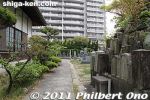
Walk past the Hondo hall toward the back and there is a cemetery that includes a special block for three graves.Jun 30, 2011
|
|
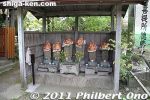
Jizo statues at Tokushoji temple.Jun 30, 2011
|
|

About Tokushoji temple in Japanese.Jun 30, 2011
|
|
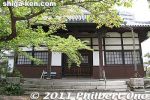
Tokushoji temple Hondo hall. In 1606, Naito Nobunari, lord of Nagahama Castle moved the temple to the present location. 徳勝寺Jun 30, 2011
|
|
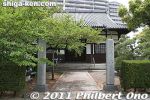
Tokushoji temple Hondo hall. The temple belongs to the Soto Buddhist Sect. After Toyotomi Hideyoshi defeated the Azai in the Battle of Anegawa and Odani Castle fell, he moved to Nagahama Castle and moved the temple to Nagahama Castle in 1595. 徳勝寺Jun 30, 2011
|
|
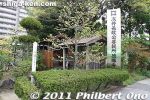
Azai Sukemasa designated Tokushoji temple as the Azai clan's family temple in 1518 and moved the temple to Shimizu Valley adjacent to Mt. Odani.Jun 30, 2011
|
|
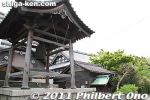
In central Nagahama (walkable from Nagahama Station) is Tokushoji temple (徳勝寺), the location of the graves of Lord Azai Nagamasa and his father Hisamasa and grandfather Sukemasa.Jun 30, 2011
|
|
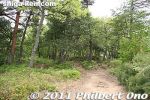
From the Sannomaru was a back road going down to Shimizu valley below where the most people lived.Jun 30, 2011
|
|
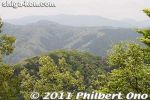
View from Sannomaru.Jun 30, 2011
|
|
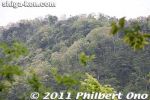
Peak of Mt. OdaniJun 30, 2011
|
|
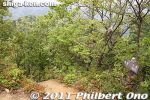
At the edge of Sannomaru is this trail going down and later up to the peak of My. Odani where the castle continues. However, I stopped here and turned back.Jun 30, 2011
|
|
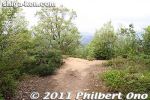
Edge of Sannomaru and trail going beyond.Jun 30, 2011
|
|
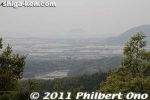
View from Sannomaru.Jun 30, 2011
|
|
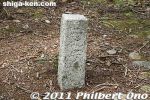
Jun 30, 2011
|
|
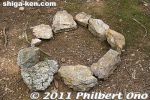
Circle of rocks in Sannomaru. Not sure what it means.Jun 30, 2011
|
|

About the Sannomaru in Japanese. The Sanno Shrine is now Odani Shrine near Mt. Odani.Jun 30, 2011
|
|

Illustration of the Sannomaru. The center section was the highest where there was the Sanno Shrine dedicated to the mountain god. You can see also how the Large Stone Wall looked, part of it remains on the upper right. Jun 30, 2011
|
|
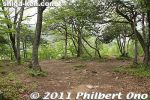
Jun 30, 2011
|
|
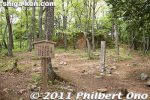
Sannomaru was quite spacious. Jun 30, 2011
|
|
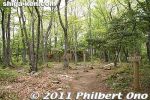
Sannomaru is 400 meters high on the mountain.Jun 30, 2011
|
|
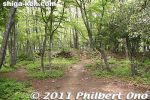
Path to Sannomaru.Jun 30, 2011
|
|
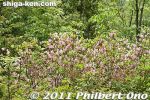
Jun 30, 2011
|
|
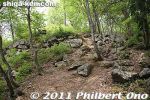
Hill of rocks.Jun 30, 2011
|
|

About the large stone wall in Japanese.Jun 30, 2011
|
|
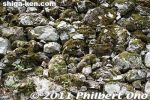
Odani Castle stone wall. Most of the stones were likely carried away to build other castles.Jun 30, 2011
|
|
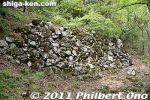
What's left of the large stone wall. It was 5 meters tall and the largest stone wall at Odani Castle, even larger than the Honmaru's stone wall.Jun 30, 2011
|
|
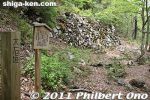
Large Stone Wall at Odani Castle. The original stone wall supported the Sannomaru bailey. 大石垣Jun 30, 2011
|
|
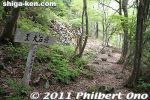
Atop a hill, a sign points to another rare stone wall.Jun 30, 2011
|
|
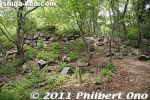
Jun 30, 2011
|
|
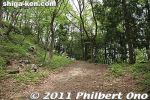
Jun 30, 2011
|
|

Jun 30, 2011
|
|

Walking further toward Sannomaru.Jun 30, 2011
|
|

About the Komaru bailey in Japanese.Jun 30, 2011
|
|
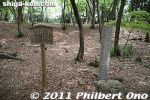
Komaru bailey is said to be where Azai Hisamasa (the second lord of Odani Castle and father of Nagamasa) retired and resided. However, under siege by Toyotomi Hideyoshi, Hisamasa is said to have committed seppuku here on Aug. 27, 1573 at age 49.Jun 30, 2011
|
|
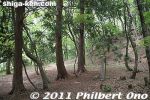
Jun 30, 2011
|
|
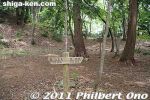
Directional signs.Jun 30, 2011
|
|
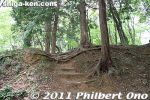
Jun 30, 2011
|
|

Jun 30, 2011
|
|
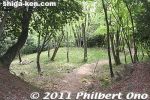
Jun 30, 2011
|
|

About the Kyogoku-maru in Japanese.Jun 30, 2011
|
|

Illustration of Kyogoku-maru which was the second largest bailey in Odani Castle after O-hiroma.Jun 30, 2011
|
|
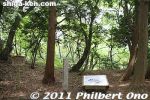
Kyogoku-maru was the site of the Kyogoku clan's residence. This residence fell to Toyotomi Hideyoshi on Aug. 27, 1573 and cut off the connection between Azai Hisamasa staying in Komaru and his son Nagamasa who was in the Honmaru.Jun 30, 2011
|
|
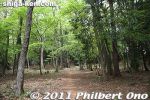
Kyogoku-maruJun 30, 2011
|
|
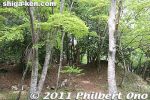
Jun 30, 2011
|
|
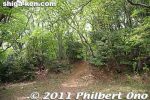
Jun 30, 2011
|
|
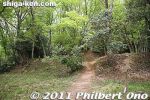
Jun 30, 2011
|
|
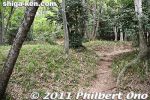
Jun 30, 2011
|
|
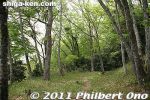
Jun 30, 2011
|
|
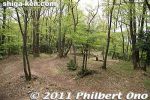
Nakanomaru as seen from Kyogoku-maru.Jun 30, 2011
|
|
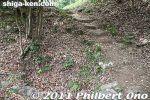
Sword-washing Pond on the left of the steps going to Kyogoku-maru.Jun 30, 2011
|
|

Stone marker for the Sword-washing Pond next to it. This is on the third and highest terrace of Nakanomaru.Jun 30, 2011
|
|
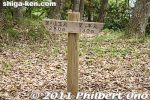
Jun 30, 2011
|
|
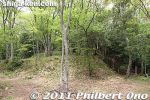
Third terrace of Nakanomaru. You can see the Sword-washing Pond marker on the right.Jun 30, 2011
|
|
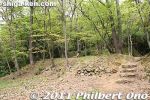
Terrace of Nakanomaru.Jun 30, 2011
|
|

Illustration of Nakanomaru. You can see the three terraces of Nakanomaru. The Honmaru is on the right, separated from Nakanomaru by the large moat.Jun 30, 2011
|
|

About the Nakanomaru bailey in Odani Castle.Jun 30, 2011
|
|

NakanomaruJun 30, 2011
|
|
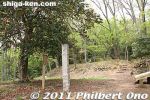
Nakanomaru had three terraces that can still be seen. 中丸Jun 30, 2011
|
|
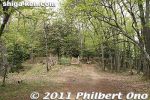
After the Honmaru, the castle spreads out further along the mountain ridge all the way to the peak. This is Nakanomaru, just north of the large moat.Jun 30, 2011
|
|

About the large moat.Jun 30, 2011
|
|
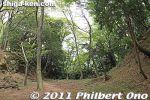
This is the deep moat right beyond the Honmaru which divided the main area of the castle into two sections.Jun 30, 2011
|
|
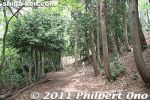
Trail going beyond the Honmaru.Jun 30, 2011
|
|
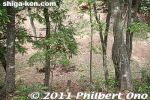
Beyond the top of the Honmaru is a deep ravine. The guided tour ended at the Honmaru, but Odani Castle has other castle keeps beyond, and I left the tour to see them by myself.Jun 30, 2011
|
|

About the Honmaru grounds in Japanese.Jun 30, 2011
|
|
|
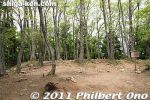
Top of the Honmaru which was the castle's central keep and focal point. Covered with trees now. This is where Azai Nagamasa lived until his defeat and the fall of the castle.Jun 30, 2011
|
|

About the Honmaru.Jun 30, 2011
|
|
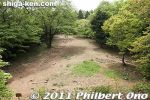
O-hiroma as seen from atop the Honmaru. Lots of rocks, not sure if any of them were foundation stones.Jun 30, 2011
|
|
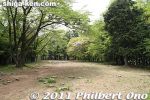
The O-hiroma Hall was said to have had 1,000 tatami mats. As seen from the Honmaru.Jun 30, 2011
|
|
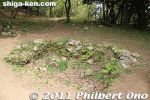
Well in the O-hiroma bailey.Jun 30, 2011
|
|
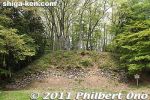
Stone wall of the Honmaru at the far end of the O-hiroma. There are steps on the right to go atop the Honmaru.Jun 30, 2011
|
|

About the O-hiroma hall in Japanese.Jun 30, 2011
|
|

Illustration of O-hiroma hall that was next to the Honmaru seen on the left.Jun 30, 2011
|
|
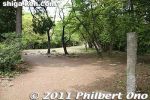
Stone marker for O-hiroma. The enclosure is about 85 meters long and 35 meters wide.Jun 30, 2011
|
|
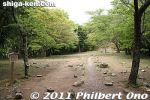
O-hiroma is Odani Castle's largest bailey. The site of a large hall where Azai Nagamasa and Ichi held their wedding. See the illustration. On the far end is the Honmaru.Jun 30, 2011
|
|
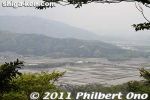
Jun 30, 2011
|
|

About the Kurogane-mon Gate in Japanese.Jun 30, 2011
|
|
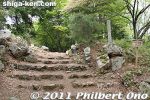
Site of Kurogane-mon Gate that was the entrance to the O-hiroma bailey. They also filmed a scene here for the NHK Taiga Drama, "Go." 黒金門Jun 30, 2011
|
|

Sakura-no-Baba also overlooks the Ouma-ya Horse Stable.Jun 30, 2011
|
|
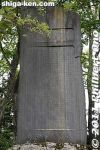
Can't read this.Jun 30, 2011
|
|
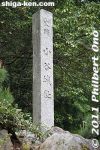
Marker for Odani Castle.Jun 30, 2011
|
|

Within the Sakura-no-Baba is this memorial for the Azai clan.Jun 30, 2011
|
|
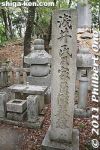
Memorial for the Azai clan in the Sakura-no-Baba. It's not a grave. Azai Nagamasa's grave (along with this father and grandfather's graves) is at Tokushoji temple in central Nagahama (photos at bottom).Jun 30, 2011
|
|

Illustration of Sakura-no-Baba Horse Grounds, seen on the slender terrace on the right, overlooking the Ouma-ya.Jun 30, 2011
|
|
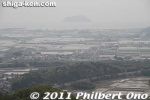
View from Sakura-no-Baba with Lake Biwa and Chikubushima island.Jun 30, 2011
|
|
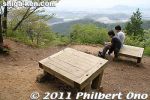
Sakura-no-Baba is also one of the best spots for scenic views atop Mt. Odani. These wooden "benches" are actually explanatory panels which never got completed.Jun 30, 2011
|
|
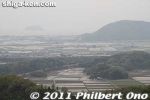
View from Sakura-no-Baba. Yamamoto-yama is on the right.Jun 30, 2011
|
|

About Sakura-no-Baba in Japanese.Jun 30, 2011
|
|
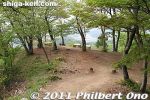
Sakura-no-Baba is between the Oumaya Horse Stable and the Ohiroma Hall.Jun 30, 2011
|
|
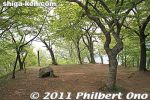
Sakura-no-Baba is where they filmed the scene in the NHK Taiga Drama "Go--Himetachi no Sengoku" when Nagamasa proposed marriage to Ichi.Jun 30, 2011
|
|
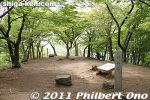
Now here is Sakura-no-Baba or Sakura Horse Grounds. This is one of the main highlights of Odani Castle due to its scenic views.Jun 30, 2011
|
|

Illustration of the Akao Yashiki residence.Jun 30, 2011
|
|

About the place where Azai Nagamasa committed seppuku and left behind his wife and three daughters who were allowed to escape.Jun 30, 2011
|
|
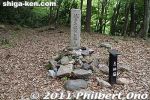
Stone marker indicating the place where Azai Nagamasa committed seppuku on Sept. 1, 1573 at age 29. Under siege by Nobunaga's forces, Nagamasa was unable to get back to the Honmaru and instead entered the Akao residence to cut his belly.Jun 30, 2011
|
|
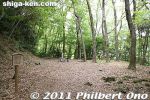
The Akao Yashiki residence was on a terraced area on the mountain slope near the foot of the Honmaru stone wall.Jun 30, 2011
|
|
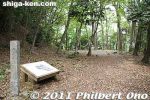
Marker for the Akao Yashiki residence. The Akao family was one of the Azai's important samurai retainers. The proximity of the residence to the Honmaru is indicative of this.Jun 30, 2011
|
|

About the Akao Yashiki residence.Jun 30, 2011
|
|
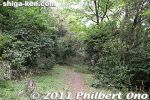
Short path to the Akao Yashiki residence. This was not part of the guided tour so I went here after the tour was over and stayed behind.Jun 30, 2011
|
|
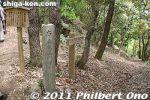
We soon came to the path leading to the Akao Yashiki residence where Azai Nagamasa committed suicide in the face of defeat by Oda Nobunaga in 1573.Jun 30, 2011
|
|

About the Head Display Stone in Japanese.Jun 30, 2011
|
|
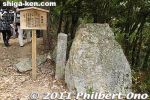
Head Display Stone is where Azai Sukemasa (first lord of Odani Castle) displayed the beheaded head of a traitor (Imai Hidenobu 今井秀信) among his samurai retainers in 1533. 首据石Jun 30, 2011
|
|
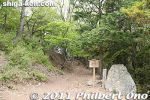
The next point of interest is a little more grisly. Jun 30, 2011
|
|

View of Mt. Ibuki from Mt. Odani.Jun 30, 2011
|
|
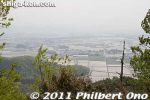
Jun 30, 2011
|
|
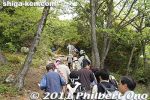
The tour was quite interesting. Our tour guide was a retired local person. It's too bad these tours would last only in 2011. It should be continued.Jun 30, 2011
|
|
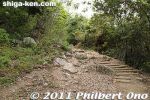
Some steps. Since the trail is not paved, it would get muddy on rainy days.Jun 30, 2011
|
|
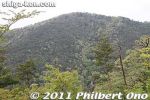
Peak of Mt. Odani as seen from the Ouma-ya.Jun 30, 2011
|
|
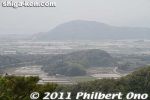
View from the Ouma-ya. That's Yamamoto-yama in the distance.Jun 30, 2011
|
|
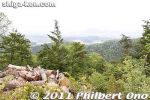
View from the Ouma-ya.Jun 30, 2011
|
|
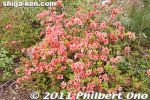
Azaleas blooming around the Horse Stable in May.Jun 30, 2011
|
|

Illustration of the Ouma-ya Horse Stable (center terrace). You can see the two Horse-washing Ponds at the foot of the stone wall.Jun 30, 2011
|
|

About the Horse Stable in Japanese.Jun 30, 2011
|
|
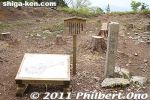
Site of the Ouma-ya Horse Stable. This castle keep was used to defend the castle's Honmaru keep. There was a water well in the center.Jun 30, 2011
|
|

Next to the Horse-washing Pond is a large area called the Ouma-ya or Horse Stable. It is not known if there actually was a horse stable here. This was enclosed on three sides by high earthen walls.Jun 30, 2011
|
|

Horse-washing Pond. There were two ponds, this bottom one to wash off the main dirt and another pond behind this one on the upper level for cleaner washing. On the left was the Horse Stable. 馬洗池Jun 30, 2011
|
|

About the Horse Washing Pond and Horse Stable in Japanese.Jun 30, 2011
|
|
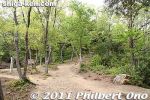
Jun 30, 2011
|
|

Jun 30, 2011
|
|
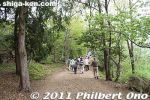
The trail is pretty level most of the way. It's not a strenuous tour.Jun 30, 2011
|
|

About the Ochaya in Japanese.Jun 30, 2011
|
|

Illustration of the Ochaya (on the lower left terrace). The area was divided into two by a dirt wall and had an L shape. It was a military outpost and included a small garden. 御茶屋跡Jun 30, 2011
|
|
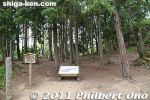
Site of the Ochaya which was right above the Bansho. It was Odani Castle's first castle keep or bailey within the castle's central area. 御茶屋跡Jun 30, 2011
|
|
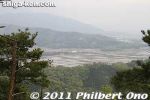
Jun 30, 2011
|
|
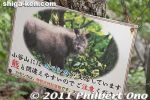
Beware of wild goats (kamoshika) on Mt. Odani.Jun 30, 2011
|
|
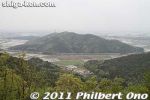
View of Mt. Toragozen (near Torahime Station on the JR Hokuriku Line) where Oda Nobunaga's troops were perched prior to their attack on Odani Castle in 1573.Jun 30, 2011
|
|
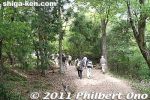
Walking further along the castle tour. The tour guide explained each site in Japanese with a megaphone. The tours were quite popular.Jun 30, 2011
|
|
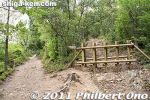
Trail blocked off.Jun 30, 2011
|
|

Illustration of Bansho guard house.Jun 30, 2011
|
|

About the Bansho in Japanese.Jun 30, 2011
|
|
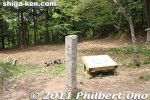
Bansho guard house site at Odani Castle. It was a security gate for castle visitors.Jun 30, 2011
|
|
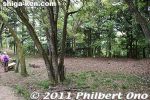
Bansho guard house siteJun 30, 2011
|
|
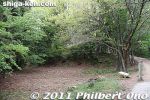
After a short walk was the Bansho guard house site here. 番所Jun 30, 2011
|
|

About the Kingo-maru keep in Japanese.Jun 30, 2011
|
|
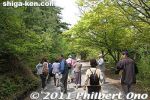
The shuttle bus goes almost halfway up Mt. Odani. We then got off the bus and walked as the tour guide led us. I went on this tour on my second visit to Odani Castle. Lot easier than the first time when I walked all the way from Kawake Station.Jun 30, 2011
|
|

The first thing we saw was this, the Kingo-maru keep, a hill. Named after Asakura Norikage (Soteki) (朝倉 教景) who was stationed here while defending the castle against Rokkaku Takayori (六角高頼) in 1525.Jun 30, 2011
|
|

At the Odani pavilion at the foot of Mt. Odani, a shuttle bus with a bus guide is provided for 500 yen roundtrip during 2011. A lot easier than walking up the mountain.Jun 30, 2011
|
|

The shuttle bus leaves once or twice an hour from Nagahama Castle. It comes with a bus guide. Jun 30, 2011
|
|
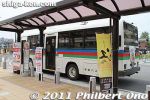
The 1,000 yen ticket includes admission to all three pavilions and roundtrip shuttle bus fare. Best to go the Odani pavilion first, then take another shuttle bus to Odani Castle.Jun 30, 2011
|
|
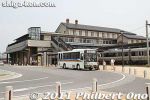
In 2011, the Go and Azai Sisters Expo was held in Nagahama. The west side of Nagahama Station had shuttle buses going to the Odani pavilion. Buy the roundtrip bus ticket at the little office near the bus stop at the train station.Jun 30, 2011
|
|

View of Lake Biwa and Chikubushima island from Mt. Odani.Jun 30, 2011
|
|

View of Lake Biwa and Chikubushima island.Jun 30, 2011
|
|
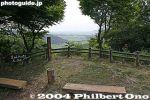
If you're walking up Mt. Odani, this is one of the best scenic viewpoints on Odani. Good place to rest too. Jun 30, 2011
|
|

Map of Mt. Odani and Odani Castle (National Historic Site). There is a series of castle keeps (maru) along the mountain ridge. Odani Castle was thus a yamajiro or mountain castle.Jun 30, 2011
|
|
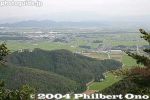
As you go higher up, the views get better.Jun 30, 2011
|
|

Otemichi path is apparently an alternate way up, but it is closed off to visitors.Jun 30, 2011
|
|
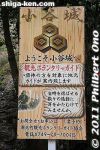
Welcome sign and phone No. for a volunteer tour guide. But even if you call, you have to make reservations and it makes no sense if you're already there.Jun 30, 2011
|
|
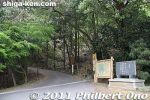
Road going up Mt. Odani. You can walk uphill (taking 30 min.), but easier if you have a car. I don't recommend walking up in the heat (and flying insects) of summer. MAPJun 30, 2011
|
|

Jun 30, 2011
|
|

Map and history of Mt. Odani and Odani Castle, a National Historic Site. Odani Castle was built around 1523.Jun 30, 2011
|
|
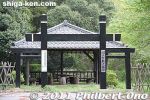
Rest house at foot of Mt. Odani.Jun 30, 2011
|
|
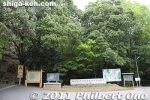
Entrance to the paved road going up the mountain. There's a small parking lot, small park, restrooms, and resthouse here.Jun 30, 2011
|
|
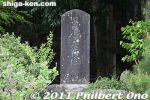
Odani Castle stone marker near the entrance to the paved road going up the mountain.Jun 30, 2011
|
|
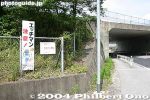
Warning sign for flashers.Jun 30, 2011
|
|
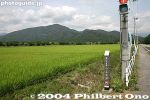
Mt. Odani in the distance. The first time I visited Odani Castle, I walked from Kawake Station. Took about 30 min. (2.4 km).Jun 30, 2011
|
|
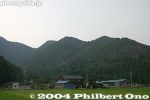
Mt. Odani has a series of peaks and the castle was built along the ridge. Odani Castle is one of Japan's five most famous mountain castles.Jun 30, 2011
|
|
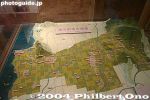
Inside Kawake Station is this model of the Odani area (formerly Kohoku town).Jun 30, 2011
|
|
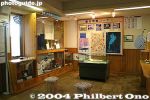
Inside Kawake Station.Jun 30, 2011
|
|
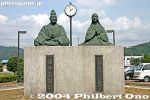
Outside Kawake Station is a statue of Lord Azai Nagamasa and wife Ichi who was Oda Nobunaga's younger sister. They lived in Odani Castle and had three famous daughters: Chacha, Hatsu, and Go.Jun 30, 2011
|
|
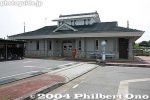
Kawake Station, on the JR Hokuriku Line, is the nearest train station to Odani Castle. There are buses from this station going to Odani Castle, but very few runs. Bicycles are available for rent though inside the station.More info on getting to Odani castle: https://shiga-ken.com/blog/2021/11/odani-castle-shuttle-buses/Jun 30, 2011
|
|
|
|